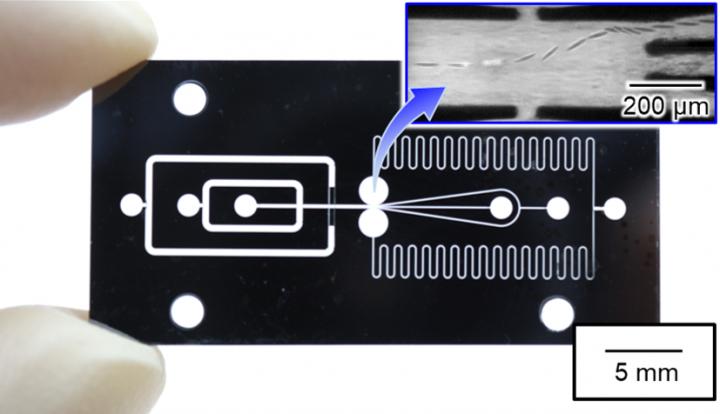On-chip pumps achieve high-speed sorting of large cells

The photograph shows the developed microfluidic chip which enables us to sort cells at high speed of 16 microseconds. The enlarged view shows a demonstration of on-chip cell sorting of a Euglena gracilis cell (time interval of each frame: 40 μs). Credit: Shinya Sakuma, Yusuke Kasai, Takeshi Hayakawa, and Fumihito Arai
The sorting of individual cells is necessary for many biological applications, including the isolation of specific cell types from cell suspensions. A fluorescence-activated cell sorting (FACS) has been used for high-throughput cell sorting.
In this method, lasers are used to excite auto-fluorescence or tagged-fluorescence of cell included in droplets, and then droplets are diverted into different containers depending on their characteristics.
However, this technique is concerned about sample infections due to aerosols generation. Additionally, a FACS of larger cells requires the samples to be processed under low pressure through wider nozzles to prevent damage. Thus, sorting is limited to low-level throughput.
Research at Nagoya University on cell sorting used a microfluidic chip to prevent sample infection. This chip has microchannels into which cell suspensions are introduced for sorting. The research group integrated two externally-driven on-chip pumps into the microfluidic chip for high-speed flow control. Using a high-speed actuator as the driving source of pump, they succeeded in producing a flow with 16 microseconds for cell sorting.
Microfluidic chip contains a cross-shaped sorting area and three-branched microfluidic channel. “Target/non-target cells are three-dimensionally aligned in the main channel,” corresponding author Shinya Sakuma says. “When target cells are detected, the on-chip pumps work rapidly to sort cells into one of two interest channels. Meanwhile, non-target cells are flushed into the waste channel without pump actuation.”
The technique allows us to sort not only large but also small cells with high speed, high purity, and high viability. “We tested the method on microalgae as an example of large cells, around 100 micrometers in size, and achieved 95.8% purity, 90.8% viability, and a 92.8% success rate,” corresponding co-author Yusuke Kasai says. “As a model small cell type, we used a cancer cell whose size is around 24 micrometers, and achieved 98.9% purity, 90.7% viability, and a 97.8% success rate.”
The article “On-chip cell sorting by high-speed local-flow control using dual membrane pumps.” was published in Lab on a Chip at DOI: 10.1039/c7lc00536a.
Media Contact
All latest news from the category: Life Sciences and Chemistry
Articles and reports from the Life Sciences and chemistry area deal with applied and basic research into modern biology, chemistry and human medicine.
Valuable information can be found on a range of life sciences fields including bacteriology, biochemistry, bionics, bioinformatics, biophysics, biotechnology, genetics, geobotany, human biology, marine biology, microbiology, molecular biology, cellular biology, zoology, bioinorganic chemistry, microchemistry and environmental chemistry.
Newest articles

Properties of new materials for microchips
… can now be measured well. Reseachers of Delft University of Technology demonstrated measuring performance properties of ultrathin silicon membranes. Making ever smaller and more powerful chips requires new ultrathin…

Floating solar’s potential
… to support sustainable development by addressing climate, water, and energy goals holistically. A new study published this week in Nature Energy raises the potential for floating solar photovoltaics (FPV)…

Skyrmions move at record speeds
… a step towards the computing of the future. An international research team led by scientists from the CNRS1 has discovered that the magnetic nanobubbles2 known as skyrmions can be…





















